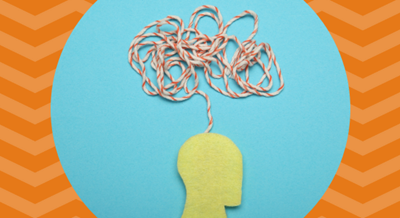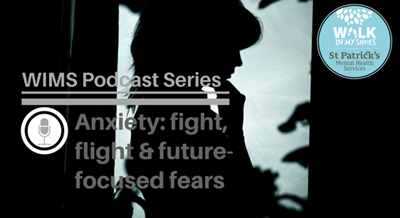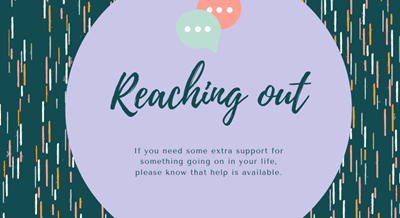What is anxiety?
When we are in a difficult situation or feel a threat, our bodies and minds want to keep us safe. Our body releases hormones, such as adrenaline, to help make us more alert and physically ready to react, and our mind focuses on the situation. This is often called the ‘fight or flight’ response.
All of us experience anxiety at different points in our lives. We all have different things that might make us anxious, and certain levels of anxiety can even be helpful at times, such as supporting us to perform well during exams.
We may need support if our feelings of anxiety:
- are much higher than the danger of the situation
- go on for several weeks or when there is no danger present
- stop us from doing or enjoying our normal activities.
In these cases, we might have an anxiety disorder. Anxiety disorders are the most common mental health difficulties for people in Ireland, along with depression.
In recent years, we have learned a lot more about anxiety and how it can be treated. There are lots of treatment options available, and most people living with anxiety can make great improvements with the right support.
Types and symptoms of anxiety disorders
In general, some signs that we may have an anxiety disorder include:
- Having physical sensations, such as a dry mouth, very quick heartbeats, or nausea
- Worrying a lot or thinking irrational thoughts
- Taking actions to avoid thinking about or dealing with difficult thoughts
- Feeling restless and on edge
- Feeling panicky or nervous.
See below to learn more about different types of anxiety disorders with their own particular symptoms.
-
Panic Disorder
If you have a panic disorder, you are likely to go through regular bursts of fear or panic, called panic attacks.
Panic attacks can feel very frightening. They can happen suddenly at any time, without any obvious reason, and they can make you feel like we have lost control.
A panic attack is really your “flight or fight” response kicking in when there is, in fact, no real threat or danger. Adrenaline in your body can cause a number of different physical and emotional sensations, which include:
- very quick breathing or feeling unable to breathe
- palpitations or a racing heartbeat
- sweating
- faintness, dizziness or light-headedness
- ringing in the ears
- chest pain
- hot or cold flushes
- fear of losing control
- fear of dying.
Almost one in five people will have a panic attack at one point in their lives. This is normal, especially when we are going through stressful times in our lives. The difference for people living with a panic disorder is that attacks come out of the blue with no obvious cause. They can leave you worried about the results of the attack or about having a future attack.
Some people can develop agoraphobia as a result of having a panic disorder.
-
Agoraphobia
Agoraphobia is fear or anxiety about being in certain places or situations. This fear comes from worry that the situation may be hard to escape from; may cause a panic attack; or may be difficult to get help in.
Examples of such situations include:
- going outside of home alone
- being in a crowded public places, such as a department stores or café
- taking public transport, like a bus or train
- being in enclosed or confined spaces, such as tunnels or lifts.
If you have agoraphobia and are facing these situations, you may feel worried about losing control, behaving embarrassingly, or being physically ill, such as fainting or having a heart attack. When you think you might be stuck in a situation where you would panic, your anxiety levels rise. This means that you might avoid lots of different situations and everyday activities. You might also stay at home or in a small area where you feel safe for very long periods of time.
-
Social anxiety
Social anxiety is when you feel extremely worried or self-conscious about social situations. Often, you feel a fear of being judged or looking foolish, and may avoid or hide away during social or performance situations, such as parties or public speaking.
Over one in eight of us will go through social anxiety at some point in our lives. It often begins when we are teenagers, but can happen at any time.
Symptoms of social anxiety are often physical, such as blushing, sweating or feeling a racing heartbeat.
You may also:
- avoid meeting new people or starting conversations
- feel that all eyes are on you
- dread public speaking, dating, or talking with people in authority
- find it difficult to do even everyday things, like talking on the phone or eating, around other people
- be afraid to go to to or use public spaces
- feel that small mistakes are much larger than they really are.
-
Obsessive Compulsive Disorder
Obessive Compulsive Disorder (OCD) is a condition where you have repetitive and distressing thoughts or behaviours.
There are two main features of OCD: obsessions and compulsions.
Obsessions are unwanted thoughts, images or impulses. They happen regularly and automatically. They can be distressing, and are difficult to control. Common obsessions include:
- being fearful of disease or infection, such as cancer or COVID-19
- feeling concerned about dirt and germs
- having thoughts or fears about violence
- being worried about harming other people, especially a loved one
- spending time and energy concerned with ordering and arranging things
- being afraid that things, such as household appliances, are unsafe.
Compulsions are also called “rituals”. They are repetitive, deliberate behaviours which respond to an obsession or follow certain rules. Completing these rituals reduces your anxiety for a short time, but the urge to carry it out again comes back even stronger. Common compulsions include:- excessive washing or cleaning, such as handwashing
- constant checking of something in particular
- repetitive actions, such as touching or counting
- arranging and ordering things, such as objects in a room
- hoarding or saving things.
Sometimes, you can have compulsions without obsessions, but they often happen at the same time.OCD can have a big impact. People living with OCD often feel that they have a lot of responsibility to stop harm, and can constantly look out for risk and danger.
OCD can start at any time in our lives, and often begins in early childhood or adolescence. It is thought that one in 100 people experience OCD at some point in their lives.
-
Generalised Anxiety Disorder
If you find it very difficult to control your worry, you may have Generalised Anxiety Disorder (GAD).
GAD is very common, with between two and eight people in every 100 experiencing it. It can happen at any time in our lives, including childhood and teenage years.
People living with GAD spend long periods of time thinking and worrying about what may go wrong in the future. This worry tends to focus on everyday themes, rather than on specific dangers, and you may feel like there is nothing you can do to ease your feelings of anxiety. This worry can also cause a lot of stress and impact on your day-to-day life, including at home or work, in school, and with friends or family.
Symptoms of GAD include:
- feeling distress
- having difficulties sleeping
- finding it hard to concentrate
- feeling exhausted.
-
Post Traumatic Stress Disorder
Post-Traumatic Stress Disorder (PTSD) can happen after you have gone through a very frightening or distressing event or experience.
Everyone experiences difficult situations, but our normal reactions to these tend to get easier over a short period of time. The kinds of events that cause PTSD are very upsetting and traumatic, and we feel intense reactions to them which last a long time.
Symptoms of PTSD include:
- having flashbacks and memories of the event
- withdrawing from our friends and family
- avoiding all reminders of the event
- being constantly alert and watching out for danger
- having trouble with sleep.
The types of events that cause PTSD can be experiences that go on for years, such as neglect in our childhood, while others may be once-off and very rare, like a terrorist attack. Examples include natural disasters, such as earthquakes or heavy floods; serious road traffic accidents; war and conflict; violence, such as mugging or robbery; unexpected injuries or illnesses in ourselves, family and friends; and more. -
Specific phobias
A specific phobia is an intense fear of a certain object or situation that poses little or no actual danger. Roughly one in 10 people have a specific phobia.
These fears often begin when we are children. They happen automatically, feel very intense, and often include a desire to avoid or escape the object or situation. These feelings are so strong that they can affect your normal routine in school and work, disrupt your social life, or impact your relationships.
Some of the most common specific phobias include:
- claustrophobia, or a fear of closed spaces
- aquaphobia, or a fear of water
- herpetophobia, or fear of reptiles or animals that crawl, like spiders
- acrophobia, or fear of heights
- injury phobia, or a fear of blood
- animal phobias, such as fears of snakes, bats, rats
- fears of getting or dying from a specific illness, such as a heart attack or cancer.
Causes of anxiety
Anxiety disorders can happen at any age, from childhood and teenage years through to adulthood and older age.
Anxiety can be a primary problem, which means it is the main symptom, and tends to follow a set pattern over several months or years. Primary anxiety disorders can happen independently of other mental health problems, but may become more severe during periods of life stress.
Anxiety can also be a secondary problem, which means that it is a symptom linked to another condition. For example, people living with depression or addiction often feel high levels of anxiety; for these people, it is important to treat the other condition rather than the symptoms of anxiety alone.
A lot of the time, one anxiety disorder can be linked with another. For example, agoraphobia can be combined with panic disorder.
Treatment for anxiety
If you are living with an anxiety disorder, help is out there. The best place to start is by letting a person you trust – like a family member or friend – know how you are feeling. Then, talk to your doctor who will be able to advise you of your options.
By learning about anxiety and our behaviours around it, we can often develop skills to manage it. There are lots of therapies which can help you with this, including Cognitive Behavioural Therapy (CBT). CBT aims to help us challenge our beliefs and behaviours, breaking the cycle of anxiety and enabling us to have more confidence in facing our fears.
Therapy can also be supported by practices such as meditation, mindfulness, and occupational therapy.Y ou might also find it helpful to take medication, such as anti-depressant drugs or, for short periods, sedative anti-anxiety drugs.
Find out more
Continue to…
Bipolar Disorder



